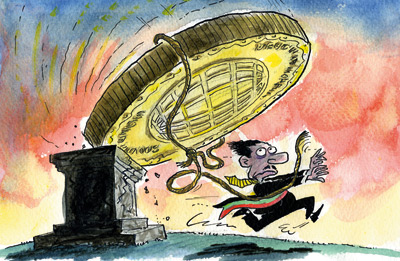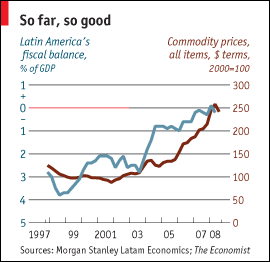
(above) Illustration by Claudio Munoz
Latin America's economies
Keeping their fingers crossed
October 2, 2008 - The Economist
In Latin America, the most trenchant opponents of globalised finance look most likely to suffer at its hands
Sáo Paulo --- IF ANALOGIES with the Great Depression are scary for Americans, they are hardly less so for Latin Americans. Within a few years of the 1929 stockmarket crash, 16 governments in the region fell to military coups or takeovers by strongmen. In recent years the talk has mostly been of Latin America’s economic independence from its big neighbour in the north (with the exception of Mexico). But on September 29th, the day the House of Representatives in Washington balked at the bail-out, came a reminder of just how close those ties still are. While the Dow Jones dropped by nearly 7% in a day, Brazil’s Bovespa, the region’s biggest stockmarket, tumbled by more than 9%.
 Even so, the fact that this financial crisis does not have “made in Latin America” stamped on it is cause for modest celebration. In the crises of 1994, 1998 and 2001 Latin America went on a binge, using foreign finance to pay for a huge rise in imports. The mood then changed, foreign money fled and panic ensued. This time many countries have had trade surpluses in recent years, and soaring commodity prices have made government finances look more than respectable (see chart).
Even so, the fact that this financial crisis does not have “made in Latin America” stamped on it is cause for modest celebration. In the crises of 1994, 1998 and 2001 Latin America went on a binge, using foreign finance to pay for a huge rise in imports. The mood then changed, foreign money fled and panic ensued. This time many countries have had trade surpluses in recent years, and soaring commodity prices have made government finances look more than respectable (see chart).
Latin American banks also look strong. This is partly because they did not hoover up American mortgage-backed securities, but also because they are not that dependent on foreign credit. Brazil’s banks are an exception: the publicly traded small and medium-sized banks that do depend on foreign funding have had their share prices pummelled over the past week. But even in Brazil, foreign capital accounts for only about 10-20% of bank-funding needs.
Equity markets in Latin America are shallow (apart from in Brazil), which reduces the chances of one path of infection. Credit is more of a concern, particularly for exporters, who are finding foreign lines of credit much harder to acquire. This may be only a temporary blip. But if it endures, companies will turn to domestic lenders instead, leaving less credit to go around. Edmar Bacha of the Banco Itaú, who has seen many crises come and go, says a credit squeeze is now his chief concern.
A bigger future fear, though, is that a global slowdown accompanied by a decline in commodity prices will put government finances under pressure. Chile, which pours money into a big fund (currently around $20 billion) when copper prices are high, and bases its budget on a copper price far below the current spot price, is the only big country in the region where the commodity boom has not been accompanied by a government spending spree. Commodity prices have already fallen back a bit. If they fall much further some countries will be in trouble.
Heading the list of those most vulnerable are countries whose markets have been viewed for some time as badly behaved: Venezuela, Argentina and Ecuador. Venezuela, which has given up producing things that its consumers want, importing them instead on the back of its oil revenues, looks particularly exposed. The same oil revenue has allowed the number of public-sector jobs to more than double since President Hugo Chávez came to power in 1999, and is also underwriting a big new arms deal with Russia. Cutting public spending is an option, but not one which he would wish to contemplate before critical regional elections at the end of November. Even then it may not be easy to switch into austerity mode. Despite a recent increase in the arrests of “foreign imperialist plotters”, Mr Chávez would find it hard to explain away large numbers of people descending onto the streets.
If lower commodity prices lead to lower costs of staple foods, this would provide Argentinians with some relief against their country’s rampaging inflation. But for President Cristina Fernández’s government it would be a different story. It gets 10% of its revenue from export taxes. A fall in commodity prices would squeeze farmers (who already pay a 35% tax on exports) even more and might reignite their recent protests. Ms Fernández might be tempted to make up the shortfall by raiding pension funds. There is also a currency concern. The peso, which has won back trust after its crash in 2001, is backed by high soyabean prices. If these fall, it could lead to a fresh flight to dollars for those able to get them, and misery for everyone else.
For well-behaved countries, such as Mexico, Brazil, Colombia and Peru, things look better. Their governments have balanced their budgets and built up trade surpluses along with dollar reserves. In some places growth is still strong: the latest year-on-year figures show an 8.3% rise in Peru for July, and 6.1% rise in Brazil for the second quarter. Not everyone is convinced by this rosy picture. “Economists who talk about structural shifts on the eve of a cyclical downturn should all be taken outside and shot,” says Gray Newman of Morgan Stanley, a bank.
Meanwhile, Mexico’s age-old linkage to the United States’ economy is already having an effect. In August remittances from Mexicans working north of the border suffered their biggest drop on record. Hopes that Americans will keep buying heroic quantities of Mexican manufactured goods are dimming. And Mexico’s trade balance, boosted by high oil prices, is at risk. Brazil, Latin America’s biggest economy, looks better placed. But commodities account for about half its exports, leaving it, too, vulnerable to a fall in prices.
The biggest difference this time around, it seems, is that those countries that have been most hostile to global capitalism look the most exposed to its changed mood. In the 1930s, the region’s democracies suffered from a crash and a depression made thousands of miles away. Today, it is the elected monarchies ruled by economic populists who have the most to fear.